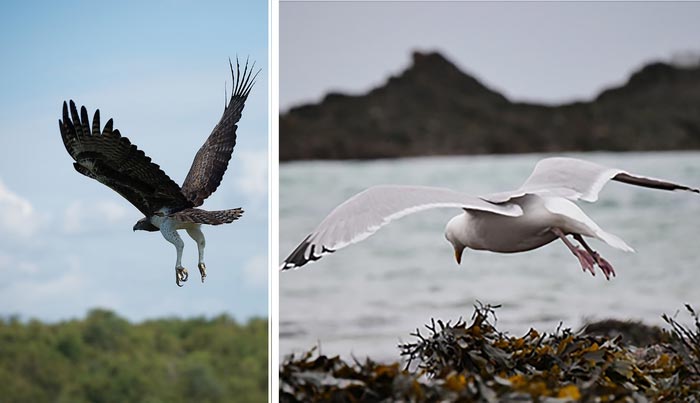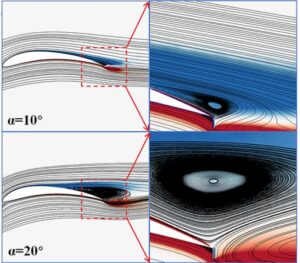Bionic wing flaps improve wind energy efficiency

Hawk (left) and seagull (right); feathers lift up as the bird descends, creating a bionic flap in their wings.
Credit: Liming Wu, Xiaomin Liu, Yang Liu, and Guang Xi
Combining engineered flaps with other structures inspired by seagull wings improves lift, reduces stalling in wind energy turbine blades.
Wind energy relies on efficient wind turbine blades, which act as airfoils, structures akin to an airplane wing. Air flow control accessories similar to those found in aircraft improve the turbine blade’s aerodynamic performance.
In the Journal of Renewable and Sustainable Energy, by AIP Publishing, scientists from China show a bionic approach combining features of a seagull’s wing with an engineered flow control accessory, known as a Gurney flap, can greatly improve wind turbine performance.
A Gurney flap is a small tab projecting at right angles from the trailing edge of a wing. Its presence disturbs wind flow patterns and is especially effective at improving performance at low angles of attack. In aerodynamics, the angle of attack is the angle between a line through the center of an aircraft wing and the oncoming flow of air.
Although Gurney flaps improve performance of airfoils at low attack angles, they are not ideal for large angles of attack. Research has shown although Gurney flaps can significantly improve the performance of wind turbines in some situations, the turbine speed will be reduced.
Bionic flow control is a relatively new approach that imitates biological flight control systems — in other words, wings and feathers. The idea comes from the observation that during landing or in a gust of wind, the feathers on the top of a bird’s wings will pop out, creating a natural flap.
Computational and experimental studies show bionic feather-inspired flaps can increase lift and delay the onset of stalling at high angles of attack. Despite their advantages, adding bionic flaps can also reduce lift, particularly before a stall sets in. Therefore, the investigators tried an approach combining Gurney flaps with bionic features.

Credit: Liming Wu, Xiaomin Liu, Yang Liu, and Guang Xi
To achieve the best aerodynamic performance, the scientists simulated the use of the combined flow control accessory in a variety of situations, including high and low angle of attack and pre- and post-stall scenarios. They compared their computational simulations to experimental results for an aircraft wing undergoing a dynamic stall.
“The overall trend of the calculated lift curve is in good agreement with the experimental measurement results. Therefore, our simulation accuracy is considered acceptable, because the dynamic stall and its control are notoriously difficult to predict,” author Xiaomin Liu said.
The combined flow control accessory effectively improves the lift coefficient of the airfoil according to Liu. “For angles of attack in the range 16 to 24 degrees, the maximum lift coefficient of the airfoil is increased by 15% when a combination of Gurney flap and bionic flap is used.”
The article “Using the combined flow control accessory to the aerodynamic performance enhancement of bio-inspired seagull airfoils” is authored by Liming Wu, Xiaomin Liu, Yang Liu, and Guang Xi. The article will appear in Journal of Renewable and Sustainable Energy on March 22, 2022 (DOI: 10.1063/5.0079060). After that date, it can be accessed at https://aip.scitation.org/doi/full/10.1063/5.0079060.
ABOUT THE JOURNAL
Journal of Renewable and Sustainable Energy is an interdisciplinary journal that publishes across all areas of renewable and sustainable energy relevant to the physical science and engineering communities. Topics covered include solar, wind, biofuels and more, as well as renewable energy integration, energy meteorology and climatology, and renewable resourcing and forecasting. See https://aip.scitation.org/journal/rse.
Journal: Journal of Renewable and Sustainable Energy
DOI: 10.1063/5.0079060
Article Title: Using the combined flow control accessory to the aerodynamic performance enhancement of bio-inspired seagull airfoils
Article Publication Date: 22-Mar-2022
Media Contact
Larry Frum
American Institute of Physics
media@aip.org
Office: 301-209-3090
All latest news from the category: Physics and Astronomy
This area deals with the fundamental laws and building blocks of nature and how they interact, the properties and the behavior of matter, and research into space and time and their structures.
innovations-report provides in-depth reports and articles on subjects such as astrophysics, laser technologies, nuclear, quantum, particle and solid-state physics, nanotechnologies, planetary research and findings (Mars, Venus) and developments related to the Hubble Telescope.
Newest articles

Innovative 3D printed scaffolds offer new hope for bone healing
Researchers at the Institute for Bioengineering of Catalonia have developed novel 3D printed PLA-CaP scaffolds that promote blood vessel formation, ensuring better healing and regeneration of bone tissue. Bone is…

The surprising role of gut infection in Alzheimer’s disease
ASU- and Banner Alzheimer’s Institute-led study implicates link between a common virus and the disease, which travels from the gut to the brain and may be a target for antiviral…

Molecular gardening: New enzymes discovered for protein modification pruning
How deubiquitinases USP53 and USP54 cleave long polyubiquitin chains and how the former is linked to liver disease in children. Deubiquitinases (DUBs) are enzymes used by cells to trim protein…


